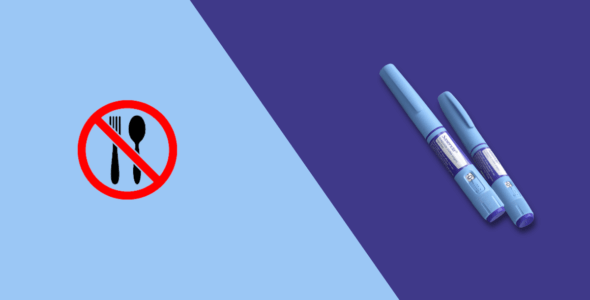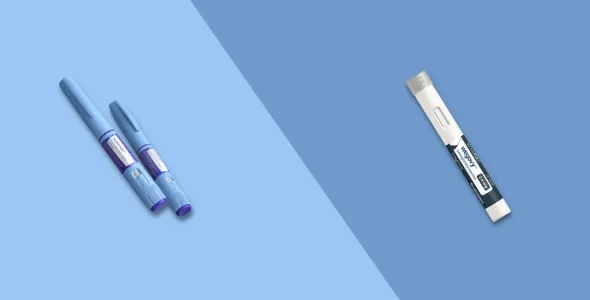What is Saxenda? The Ultimate Guide
This once-daily injection is changing the way people approach weight management by working with your body’s natural signals to help you feel full, eat less, and lose weight. Keep reading to learn more about Saxenda.
Key highlights
- Saxenda (liraglutide) is an FDA-approved injectable medication used for chronic weight management in adults with obesity or overweight and related health conditions.
- It works by reducing hunger and helping you feel full longer, which leads to weight loss and may also improve blood sugar, blood pressure, and cholesterol levels.
- Saxenda is different from other weight-loss medications like Wegovy and Ozempic; it uses a different ingredient (liraglutide) and must be taken every day instead of weekly.
- Saxenda may not be for everyone, so it’s important to talk to your doctor about your health, weight goals, and whether this medication is right for you.
Overweight and obesity rates have been steadily rising in the U.S., affecting over 70% of adults. This growing public health concern underscores the urgent need for effective, sustainable treatment options.
Saxenda is an FDA-approved glucagon-like peptide-1 (GLP-1) receptor agonist used for chronic weight management in adults and adolescents with obesity or weight-related conditions.
Get a comprehensive and easy-to-understand explanation of Saxenda, including what it is, how it works, its benefits, potential side effects, who it’s for, and other essential information for patients in the U.S. considering this weight management option.
What is Saxenda?
Saxenda is a glucagon-like peptide-1 (GLP-1) medication with the same active ingredient as Victoza (approved for type 2 diabetes), liraglutide. It’s used for chronic weight management in combination with a reduced-calorie diet and increased physical activity in adults with obesity or overweight.
The active ingredient in Saxenda is liraglutide, a type of GLP-1 receptor agonist. Liraglutide works by mimicking a hormone in the body that helps control blood sugar levels and appetite, leading to significant weight loss.
Saxenda is a daily injection approved for weight loss. Approved in 2014, Saxenda (liraglutide) was the first GLP-1 medication approved for weight loss in adults with obesity or overweight with at least one weight-related health condition, such as high blood pressure or high cholesterol. It is also approved for certain children 12 and older with obesity.
Saxenda, being an older GLP-1 medication, has some downsides compared to newer weight loss medications like Zepbound and Wegovy. For example, it’s taken daily instead of weekly, and you might lose less weight with it.
In a 56-week clinical trial, people taking Saxenda 3 mg once a day lost an average of 18 lbs, while those using a placebo injection only lost 8 lbs. It has also shown heart health benefits for people with diabetes or those at high risk of heart disease.
Key differences vs. Wegovy and Ozempic
Saxenda contains liraglutide, while Wegovy and Ozempic contain semaglutide, a different but similar GLP-1 receptor agonist. Semaglutide is generally more potent and longer-acting.
Primary use:
- Saxenda is FDA-approved specifically for weight management.
- Wegovy is also approved for chronic weight management but has higher efficacy.
- Ozempic is approved for type 2 diabetes, though it’s often used off-label for weight loss.
Victoza (liraglutide) is approved for type 2 diabetes, not weight loss, though it uses the same active ingredient as Saxenda at a lower dose.
Dosage differences:
- Saxenda: Liraglutide up to 3.0 mg daily (weight loss)
- Victoza: Liraglutide up to 1.8 mg daily (diabetes)
- Wegovy: Semaglutide up to 2.4 mg weekly (weight loss)
- Ozempic: Semaglutide 0.5 to 2.0 mg weekly (diabetes)
Saxenda is a daily injection designed specifically for weight management, while Wegovy (weekly) may offer greater weight loss. Victoza and Ozempic are mainly used for diabetes but share the same GLP-1 hormone pathway. The best choice depends on your health goals and medical needs.
How does Saxenda work for weight loss? The science explained
Saxenda (liraglutide) is a prescription weight-loss medication that works by mimicking a natural hormone in the body called GLP-1 (glucagon-like peptide-1). This hormone plays a key role in regulating appetite, digestion, and blood sugar levels.
Saxenda targets the hypothalamus, the area of the brain that controls hunger. It helps reduce appetite and food cravings by affecting appetite-regulating pathways, making you feel less hungry.
It slows down the emptying of the stomach, which means food stays in your system longer. This helps you feel full for a longer time after eating, reducing the urge to snack or overeat.
Saxenda also improves blood sugar control by enhancing insulin sensitivity and reducing glucose production. While it’s not primarily used for diabetes at the 3 mg dose, it can help stabilize blood sugar levels, even in people without diabetes.
In clinical trials (SCALE study), patients using Saxenda lost an average of 5% to 10% of their body weight over one year when combined with a reduced-calorie diet and increased physical activity.
By mimicking GLP-1 and acting on multiple systems in the body, Saxenda helps support sustainable weight loss through appetite regulation, increased satiety, and metabolic improvements.
Who is Saxenda for? Eligibility criteria
Saxenda is FDA-approved for chronic weight management in adults with:
- A Body Mass Index (BMI) of 30 or higher (obesity)
- A BMI of 27 or higher (overweight) who also have at least one weight-related health condition, such as high blood pressure, Type 2 diabetes, or high cholesterol
Saxenda is also FDA-approved for use in adolescents (12-17 years old):
- Those who weigh over 132 pounds and are considered obese based on adult BMI
- Obese, or overweight, with at least one weight-related condition such as high blood pressure, type 2 diabetes, or high cholesterol
Saxenda must be used in conjunction with a reduced-calorie diet and increased physical activity.
Who should not take Saxenda? Contraindications and warnings
Saxenda comes with a box warning about the possible risk of thyroid tumors. People with a personal or family history of medullary thyroid cancer (MTC) or multiple endocrine neoplasia type 2 (MEN 2) should avoid this medication.
Saxenda can increase heart rate, which may cause problems for people with heart disease or high blood pressure. It also carries risks like pancreatitis, gallbladder disease, kidney problems, and suicidal thoughts or behaviors. Low blood sugar (hypoglycemia) is another risk, especially for people taking other diabetes medications.
Get medical help right away if your side effects last or get worse. You should seek emergency care if you have signs of an allergic reaction, like hives, swelling in your face or throat, or trouble breathing.
Boxed warning
Saxenda (liraglutide) carries an FDA-boxed warning due to the risk of thyroid C-cell tumors or thyroid cancer observed in animal studies.
In rodent studies, GLP-1 receptor agonists like Saxenda and Wegovy caused thyroid C-cell tumors, including medullary thyroid carcinoma (MTC).
It’s not known whether these findings apply to humans, but the potential risk cannot be ruled out.
Do NOT use Saxenda if:
- You have a personal or family history of MTC, a rare type of thyroid cancer
- You have been diagnosed with Multiple Endocrine Neoplasia syndrome type 2 (MEN 2), a genetic condition linked to endocrine tumors
- Serious allergic reaction to liraglutide or any of the ingredients in Saxenda.
- Are pregnant or planning to become pregnant
- Are breastfeeding, as it is not known if Saxenda passes into breast milk
- Have serious kidney or liver problems
Dosage and administration
Saxenda pen is a once-daily injection administered under the skin (subcutaneously). You can inject the medication under the skin of your stomach, upper arm, or thigh.
Store the Saxenda pre-filled pen in the refrigerator at a temperature between 36°F to 46°F (2°C to 8°C) before first use. Once you start using the pen, it can be kept at room temperature, up to 86°F (30°C), for a maximum of 30 days.
Be sure to protect the pen from light and heat during storage. Do not freeze Saxenda, and if it has been frozen, do not use it. Always keep the pen capped when it is not in use to maintain its effectiveness.
The starting dose of Saxenda is 0.6 mg once daily, which is used during the first week to help your body adjust and minimize side effects like nausea. The dose is then gradually increased each week until the maintenance dose of 3.0 mg is reached by the fifth week if tolerated. It should be continued as long as it’s effective and well-tolerated.
Saxenda is used up to 3 mg daily, while generic liraglutide (Victoza equivalent) only goes up to 1.8 mg daily.
If the patient has not lost at least 4% of their body weight after 16 weeks at the maintenance dose, treatment may be discontinued, as further benefit is unlikely.
The titration schedule of Saxenda is:
- Titration schedule: Increases by 0.6 mg each week
- Starting dose: 0.6 mg daily
- Maintenance dose: 3.0 mg daily
- Time to reach full dose: Typically reached by week 5 if tolerated by the patient
Benefits of Saxenda
Saxenda offers several potential benefits beyond just losing weight, making it a valuable option for people with obesity or overweight and related health concerns:
- Significant and sustained weight loss: Clinical trials show that patients using Saxenda can lose an average of 5% to 10% of their body weight when combined with a reduced-calorie diet and increased physical activity. Some patients achieve even greater results with consistent use.
- Improvement in weight-related health conditions: Saxenda has been shown to help improve blood pressure, lower LDL (bad) cholesterol, and stabilize blood sugar levels, especially in people with prediabetes or type 2 diabetes.
- Better appetite control: As a GLP-1 receptor agonist, Saxenda helps regulate appetite and reduce cravings, making it easier to stick to healthy eating habits.
- Improved quality of life: Many patients report better energy levels, increased mobility, improved mood, and higher confidence as a result of weight loss and better health.
- Approved for adolescents: Saxenda is also FDA-approved for weight management in adolescents 12–17 years of age with obesity, offering an important treatment option for younger individuals struggling with weight-related issues.
These benefits highlight Saxenda’s role not just as a weight-loss drug, but as part of a comprehensive approach to improving overall health and well-being.
Potential side effects
The most common side effects of Saxenda are usually mild and tend to improve over time:
- Nausea
- Vomiting
- Diarrhea
- Constipation
- Headache
- Stomach pain
- Dizziness
- Fatigue
- Hoarseness
- Hypoglycemia or low blood sugar (especially when used with diabetes medications)
- Decreased appetite
- Trouble swallowing
Rare and serious side effects of Saxenda that may require immediate medical attention include:
- Pancreatitis (inflammation of the pancreas)
- Gallbladder problems (gallstones)
- Kidney problems (including kidney failure)
- Increased heart rate or fast heartbeat
- Injection site reactions
- Suicidal thoughts
- Serious allergic reactions
Here are some tips to help manage Saxenda side effects:
- Eat low-fat, plain foods
- Limit spicy foods and alcohol
- Eat slowly and avoid lying down right after eating
- Try walking for 10 minutes or more after eating
- Wear loose clothing
It’s essential to remember that any changes to your weight loss medication, whether starting, stopping, or switching, depend on your medical condition and should only be made under the medical advice of a qualified healthcare provider. Always tell your doctor or pharmacist about all over-the-counter medications, supplements, and vitamins you take.
Saxenda vs. other weight loss medications
Saxenda (liraglutide) is one of several FDA-approved weight loss medications, each working differently and offering unique benefits.
- Mechanism of action: Saxenda and Wegovy (semaglutide) are GLP-1 receptor agonists that help reduce appetite and food intake. Zepbound (tirzepatide) targets both GLP-1 and GIP receptors for enhanced effect. Contrave combines bupropion and naltrexone to influence brain pathways controlling hunger and cravings. Qsymia combines phentermine (an appetite suppressant) and topiramate (used for seizures/migraines) to reduce appetite. Orlistat works in the gut to block fat absorption.
- Efficacy: Wegovy and Zepbound generally lead to more significant weight loss than Saxenda, often 15–20% of body weight. Saxenda typically leads to 5–10% weight loss. Contrave and Qsymia show moderate weight loss, while Orlistat has more modest effects.
- Administration: Saxenda, Wegovy, and Zepbound are injectable (daily for Saxenda; weekly for Wegovy and Zepbound). Contrave, Qsymia, and Orlistat are taken orally.
- Key differences: Saxenda may be preferred by those needing a daily routine, while weekly injections like Wegovy and Zepbound offer convenience. Oral options may be easier for those uncomfortable with injections. Each medication has different side effect profiles, contraindications, and insurance coverage considerations.
The best weight loss medication depends on individual health conditions, preferences, lifestyle, and how well a person tolerates the treatment. A healthcare provider can help determine the most appropriate option.
Here’s a comparison of Saxenda and other FDA-approved weight loss medications based on key factors:
| Medication | Active Drug | Dose Frequency | Avg. Weight Loss | Common Side Effects | Est. Monthly Cost |
|---|---|---|---|---|---|
| Saxenda | Liraglutide | Daily injection | 5–10% of body weight | Nausea, diarrhea, vomiting, constipation | $1,300 (may vary with insurance) |
| Wegovy | Semaglutide | Weekly injection | 15% or more of body weight | Nausea, diarrhea, vomiting, constipation | $1,300 (may vary with insurance) |
| Zepbound | Tirzepatide | Weekly injection | 15–22% of body weight | Nausea, diarrhea, vomiting, constipation | $1,100–$1,300 |
| Qsymia | Phentermine/Topiramate | Daily oral | 6–9% of body weight | Constipation, dry mouth, tingling, insomnia | $200–$300 (with discount programs) |
| Contrave | Bupropion/Naltrexone | Daily oral | 5–9% of body weight | Nausea, constipation, headache, insomnia | $100–$200 (with discount programs) |
| Orlistat | Orlistat | 3x daily oral (with meals) | 3–5% of body weight | Diarrhea, oily stools, flatulence, abdominal pain | $80–$150 (generic available) |
Always consult a healthcare provider to determine which option is safest and most effective for your needs.
Cost and insurance coverage
The list price for a 30-day supply of Saxenda is approximately $1,349.02. Without insurance, the average monthly cost is around $1,300.
Insurance coverage for this medication can differ depending on the plan, but most insurance plans don’t cover weight-loss treatments. Some plans may cover Saxenda, while others may not, so many patients might have to pay the full price. A month’s supply of Saxenda costs about $1,300 without insurance.
The coverage for drugs varies by insurance plan. Some plans may cover them, but it is not typically covered by Medicare Part D for weight loss.
How to save on Saxenda
Here are some strategies that can be used to save on Saxenda:
Check insurance coverage
Look up your health plan’s formulary to see if Saxenda is covered. Ask your insurance provider if there are any prior authorization or step therapy requirements that may apply. Have your provider’s office help with the insurance approval process if needed.
Saxenda Savings Card program
Novo Nordisk, the manufacturer of Saxenda, offers a Saxenda savings card program, which is eligible for commercially insured patients who may pay as little as $25 per 30-day prescription.
This card can be used at participating pharmacies. It is not valid for patients on Medicare, Medicaid, or other federal/state healthcare programs.
Pharmacy discount cards
Free discount programs like GoodRx, SingleCare, and WellRx may help lower out-of-pocket costs if you’re paying cash.
Prices can vary, so it’s worth comparing across all prescription drug discount websites and local pharmacies.
Generic liraglutide
The FDA approved generic liraglutide (Victoza), the first generic of a once-daily GLP-1 injection, in December 2024.
As of May 2025, no generic Saxenda (liraglutide for weight loss) is available in the U.S. However, a generic version of Victoza, the type 2 diabetes version of liraglutide, has been approved.
On December 23, 2024, the US FDA approved Hikma Pharmaceuticals’ generic version of Victoza (liraglutide injection 18 mg/3 mL) for type 2 diabetes in adults and pediatric patients 10 years and older. This approval was part of the FDA’s efforts to address drug shortages and give patients access to essential medications.
The FDA also approved a generic version of Victoza from Nanjing King-Friend Pharmaceutical on April 2, 2025.
Compounded liraglutide
Compounded liraglutide is made by compounding pharmacies, which mix medications tailored to individual needs, often when the original drug is unavailable or too expensive. Unlike FDA-approved medications like Saxenda or Victoza, compounded drugs are not reviewed for safety, effectiveness, or quality by the FDA. This means there could be risks, such as incorrect strength, contamination, or improper storage.
If you’re considering compounded liraglutide, it’s important to speak with a healthcare provider. They can help you weigh the risks and benefits and ensure you’re using a product from a reputable source if it’s appropriate for you.
Discuss alternatives with your doctor
Ask your healthcare provider if other GLP-1 meds (Wegovy, Ozempic, or even generic liraglutide) might be an option, knowing they may have different indications, dosing, and effects.
Other weight loss medications like Contrave, Qsymia, or Phentermine may be cheaper and have generic versions.
Is Saxenda right for you?
Saxenda may be a suitable option for individuals who meet the BMI criteria for overweight or obesity and have weight-related health conditions such as type 2 diabetes or high blood pressure.
It’s most effective when combined with a reduced-calorie diet and increased physical activity. People considering Saxenda should be prepared to make long-term lifestyle changes, feel comfortable with daily injections, and understand the possible side effects and risks.
You might choose Saxenda if you:
- Prefer daily dosing: Some people find it easier to manage a medication that’s taken daily, especially if they want more control over side effects or faster dose adjustments. Saxenda is injected once a day, which allows for more gradual titration compared to weekly shots like Wegovy.
- Have milder weight loss goals: Saxenda tends to lead to moderate weight loss, often in the range of 5–8% of body weight. This may be enough for people with less weight to lose or those aiming for smaller, sustainable changes.
- Can tolerate liraglutide better: Saxenda contains liraglutide, which some patients tolerate better than semaglutide (in Wegovy). For example, people who experience severe constipation or nausea on Wegovy may find Saxenda gentler on the digestive system.
It’s also important to review medical history, current medications, and the cost or insurance coverage. An open and honest conversation with a healthcare provider is essential to determine if Saxenda is the right fit for your individual needs and health goals.
Saxenda alternatives
You can also discuss alternative GLP-1 drugs with your doctor including:
Wegovy (semaglutide)
Both Saxenda (liraglutide) and Wegovy (semaglutide) are GLP-1 receptor agonists approved for weight loss, but they differ in cost and insurance coverage.
Insurance coverage for these medications can differ depending on the plan, but most insurance plans don’t cover weight-loss treatments. Some plans may cover Saxenda or Wegovy, while others may not, so many patients might have to pay the full price. A month’s supply of Saxenda and Wegovy costs about $1,300 without insurance.
The coverage for both drugs varies by insurance plan. Some plans may cover them, but they are not typically covered by Medicare Part D for weight loss.
Victoza (liraglutide)
Victoza (liraglutide) is a once-daily injectable medication approved by the U.S. Food and Drug Administration (FDA) for managing type 2 diabetes in adults and children aged 10 years and older. It works by enhancing insulin release in response to meals, thereby improving blood sugar control when used alongside diet and exercise.
While not specifically approved for weight loss, some individuals with type 2 diabetes may experience modest weight reduction as a secondary benefit of Victoza. In clinical studies, patients using Victoza alone or in combination with other diabetes medications like metformin have reported average weight losses ranging from 4.6 to 6.2 pounds over 26 to 52 weeks.
Mounjaro (tirzepatide)
Mounjaro (tirzepatide) is an FDA-approved medication to improve blood sugar levels in adults with type 2 diabetes. It’s also prescribed off-label for reducing body weight combined with diet and exercise.
Mounjaro works by targeting two hormones (GLP-1 and GIP), unlike Ozempic, which only targets GLP-1, which may explain its stronger effects. It’s a powerful option, but the higher cost can be a barrier for many patients.
Mounjaro is a newer injectable medication that is more potent than Ozempic for both blood sugar control and weight loss. However, it is also more expensive and may not be covered by all insurance plans.
Saxenda FAQs
Is Saxenda the same as Ozempic?
No, Saxenda and Ozempic are not the same, though both are injectable medications used for weight-related conditions. Saxenda contains liraglutide, while Ozempic contains semaglutide and is primarily used to treat type 2 diabetes.
How fast do you lose weight on Saxenda?
Weight loss with Saxenda varies, but many people start seeing results within the first 8 to 12 weeks. On average, patients may lose 5% to 10% of their body weight over several months with proper diet and exercise.
Can you stop Saxenda suddenly?
Yes, you can stop Saxenda suddenly, but it’s best to do so under your doctor’s guidance. Stopping may lead to weight regain if lifestyle changes aren’t maintained.
Does Saxenda cause hair loss?
Hair loss is not a common side effect of Saxenda, but some users have reported it anecdotally. It may be related to rapid weight loss rather than the medication itself.
Conclusion
Saxenda is an FDA-approved daily injectable medication that helps with weight management by reducing appetite, increasing fullness, and supporting moderate, sustainable weight loss.
It’s most suitable for individuals who prefer daily injections and are aiming for gradual, steady progress.
If you are looking for more significant weight loss or a once-weekly option, you might consider alternatives like Wegovy or Zepbound.
Saxenda is an effective weight loss medication that works best when combined with healthy eating, physical activity, and guidance from a healthcare provider.
Always consult a healthcare professional to seek medical advice for personalized guidance on weight loss treatments.




